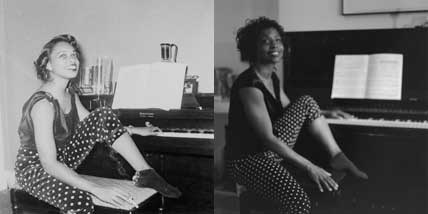
Lorna Simpson (American, b. 1960). 1957–2009 Interiors (detail), 2009. Gelatin silver prints, 51⁄2 x 51⁄2 in. (14 × 14 cm) each, overall dimensions variable. © 2009 Lorna Simpson. Courtesy of the artist and Salon 94, New York

Lorna Simpson (American, b. 1960). 1957–2009 Interiors (detail), 2009. Gelatin silver prints, 51⁄2 x 51⁄2 in. (14 × 14 cm) each, overall dimensions variable. © 2009 Lorna Simpson. Courtesy of the artist and Salon 94, New York

Lorna Simpson (American, b. 1960). Please remind me of who I am, 2009. 50 found photo booth portraits, 50 ink drawings on paper, bronze frames. 2 × 1.5 inches each (5.1 × 3.8 cm); overall dimensions variable. © Lorna Simpson, 2009; Collection of Isabelle and Charles Berkovic, Brussels

Lorna Simpson (American, b. 1960). Please remind me of who I am, 2009. 50 found photo booth portraits, 50 ink drawings on paper, bronze frames. 2 × 1.5 inches each (5.1 × 3.8 cm); overall dimensions variable. © Lorna Simpson, 2009; Collection of Isabelle and Charles Berkovic, Brussels
Simpson has collected large numbers of historical images of unidentified African Americans posing for photo-booth portraits and integrated them into a series of multipart pieces. For this unique installation, Simpson recombines three of these works into one large arrangement.
The photo booth debuted in New York City in 1925, quickly becoming a popular form of entertainment while also serving as a practical and inexpensive way for people to make images of themselves. Coinciding with the mass availability of this new technology was the “Great Migration” of an estimated two million African Americans from the southern states to the industrialized North, an exodus driven by a search for employment opportunities and escape from the overt racism of the South. In this context, private photo-booth portraits take on greater cultural significance, as many were carefully crafted messages sent back home to loved ones. While the portraits are captivating, the lack of information and personal detail about the sitters can be heartrending. This sense of a missing history is reinforced by the shadow images interspersed among the photographs. Simpson has compared these to the paper residue found in old photo albums where images have been torn out.

Lorna Simpson (American, b. 1960). 1957–2009 Interiors (detail), 2009. Gelatin silver prints. 51⁄2 x 51⁄2 inches each (14 × 14 cm); overall dimensions variable. © Lorna Simpson, 2009; Rennie Collection, Courtesy of the artist and Salon 94, New York

Lorna Simpson (American, b. 1960). 1957–2009 Interiors (detail), 2009. Gelatin silver prints. 5 1⁄2 x 51⁄2 inches each (14 × 14 cm); overall dimensions variable. © Lorna Simpson, 2009; Rennie Collection, Courtesy of the artist and Salon 94, New York

Lorna Simpson (American, b. 1960). 1957–2009 Interiors (detail), 2009. 52 gelatin silver prints. 51⁄2 x 51⁄2 inches each (14 × 14 cm); overall dimensions variable. © Lorna Simpson, 2009; Rennie Collection, Courtesy of the artist and Salon 94, New York

Lorna Simpson (American, b. 1960). 1957–2009 Interiors (detail), 2009. 52 Gelatin silver prints. 51⁄2 x 51⁄2 inches each (14 × 14 cm); overall dimensions variable. © Lorna Simpson, 2009; Rennie Collection, Courtesy of the artist and Salon 94, New York
Simpson found a large group of photographs on eBay of an African American woman—and in several instances, a young man—posing in modest domestic settings in Los Angeles in 1957. Most of the photographs resemble pinups, mass-produced images popularized in the World War II era that showed a pretty girl, often a B-movie actress, in a seductive pose. By the 1950s, the ubiquity of the pinup, combined with the popularity of camera clubs for hobbyists, resulted in a burgeoning cottage industry for amateur girlie pictures like the ones seen here. But the questions the photographs raise easily outnumber any known facts about the subjects. In response to this lack of information and to the artifice and apparent self-consciousness of the models’ poses, Simpson made her own self-portraits mimicking the originals, marking the first time the artist has included her own image in her work. By positioning herself as a contemporary reflection of an unknown individual from fifty years ago, Simpson seems to be trying to replicate the original person’s experience, perhaps in order to catch a glimmer of a life that can never really be known.

Lorna Simpson: Gathered
January 28–August 21, 2011
Lorna Simpson: Gathered presents works that explore this Brooklyn-born artist’s interest in the interplay between fact and fiction, identity and history. Through works that incorporate hundreds of original and found vintage photographs of African Americans that she collects from eBay and flea markets, Lorna Simpson undermines the assumption that archival materials are objective documents of history.
In one series, titled May June July August, ‘57/‘09, comprising 123 vintage and contemporary black-and-white photographs, Simpson juxtaposes images of a young African American woman (and an occasional male figure) who posed for pinups in Los Angeles in 1957 with self-portraits in which the artist acts as a doppelganger for the model. She replicates with precise detail the poses and settings of the original photographs, arranging the work in grid patterns. Linking the historical photographs with her staged responses creates a fictionalized narrative in which the two characters appear to be linked across history in a shared identity or destiny.
The exhibition also includes examples of Simpson’s series of installations of black-and-white photo-booth portraits of African Americans from the Jim Crow era and a film work.
Lorna Simpson: Gathered is organized by Catherine Morris, Curator of the Elizabeth A. Sackler Center for Feminist Art, Brooklyn Museum.
This exhibition is made possible by the Elizabeth A. Sackler Foundation.
